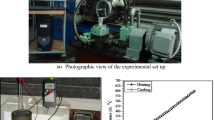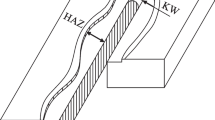Abstract
Laser-assisted machining (LAM) is considered an efficient method for the processing of fused silica. In this study, an analysis model based on artificial neural network (ANN) with Bayesian regularization algorithm (BR) was used to investigate the effects of the machine parameters (rotation speed, feed rate, cutting depth, and pulse duty ratio) on the resultant cutting force during the LAM of fused silica. Its prediction capability was validated experimentally and evaluated quantitatively. The optimal combination of machine parameters corresponding to the minimum resultant cutting force was then studied using the genetic algorithm (GA) coupled with the established ANN model. Moreover, the optimal numerical solution was verified experimentally, and the processing quality under optimal machine parameters was characterized through analyzing the surface morphology and roughness. In addition, the performances of prediction and optimization of ANN model were compared with the model based on response surface methodology (RSM). And the mean absolute error in prediction and the optimal cutting force are reduced by 34.47% and 19.11% respectively, compared to RSM. The results clearly show that the ANN model achieves a better behavior in studying the influence of the machine parameters during the LAM of fused silica.
Similar content being viewed by others
References
HawleyFedder RA, Stolz CJ, Menapace JA, Borden MR, Yu J, Runkel MJ, Feit MD (2004) NIF optical materials and fabrication technologies: an overview. Proc SPIE Int Soc Opt Eng 5341: 102–105
Zhou C, Zhang Q, He C, Li Y (2014) Function of liquid and tool wear in ultrasonic bound-abrasive polishing of fused silica with different polishing tools. Optik - Intern J Light Electron Opt 125:4064–4068
Germain G, Lebrun JL, Braham-Bouchnak T, Bellett D, Auger S (2008) Laser-assisted machining of Inconel 718 with carbide and ceramic inserts. Int J Mater Form 1:523–526
Bocanegra-Bernal MH, Matovic B (2009) Dense and near-net-shape fabrication of Si3N4 ceramics. Mater Sci Eng, A 500:130–149
Ding H, Shin YC (2010) Laser-assisted machining of hardened steel parts with surface integrity analysis. Intern J Mach Tools Manuf 50:106–114
Attia H, Tavakoli S, Vargas R, Thomson V (2010) Laser-assisted high-speed finish turning of superalloy Inconel 718 under dry conditions. CIRP Ann Manuf Technol 59:83–88
Tadavani SA, Razavi RS, Vafaei R (2017) Pulsed laser-assisted machining of Inconel 718 superalloy. Opt Laser Technol 87:72–78
Rashid RAR, Sun S, Wang G, Dargusch MS (2012) An investigation of cutting forces and cutting temperatures during laser-assisted machining of the Ti–6Cr–5Mo–5V–4Al beta titanium alloy. Intern J Mach Tools Manuf 63:58–69
Sun S, Harris J, Brandt M (2010) Parametric investigation of Laser-Assisted machining of commercially pure titanium. Adv Eng Mater 10:565–572
Chang C, Kuo C (2007) An investigation of laser-assisted machining of Al2O3 ceramics planing. Int J Mach Tools Manuf 47:452–461
Venkatesan K, Ramanujam R, Kuppan P (2014) Analysis of cutting forces and temperature in laser assisted machining of inconel 718 using taguchi method. Procedia Eng 97:1637–1646
Kim J-H, Kim K-S, Choi J-Y, Lee C-M (2012) Estimation of deformed laser heat sources and thermal analysis on laser assisted turning of square member. J Cent South Univ 19:402–407
Kumar R, Chauhan S (2015) Study on surface roughness measurement for turning of Al 7075/10/SiCp and Al 7075 hybrid composites by using response surface methodology (RSM) and artificial neural networking (ANN). Measurement 65:166–180
Karabulut S (2015) Optimization of surface roughness and cutting force during AA7039/al 2 O 3 metal matrix composites milling using neural networks and Taguchi method. Measurement 66:139–149
Davim JP, Gaitonde VN, Karnik SR (2008) Investigations into the effect of cutting conditions on surface roughness in turning of free machining steel by ANN models. J Mater Process Technol 205:16–23
Kant G, Sangwan KS (2015) Predictive modelling and optimization of machining parameters to minimize surface roughness using artificial neural network coupled with genetic algorithm. Procedia Cirp 31:453–458
Sangwan KS, Saxena S, Kant G (2015) Optimization of machining parameters to minimize surface roughness using integrated ANN-GA approach. Procedia Cirp 29:305–310
Nakhjavani OB, Ghoreishi M (2006) Multi criteria optimization of laser percussion drilling process using artificial neural network model combined with genetic algorithm. Mater Manuf Process 21:11–18
Song H, Dan J, Chen X, Xiao J, Xu J (2018) Experimental investigation of machinability in laser-assisted machining of fused silica. Int J Adv Manuf Technol 97(1):267–278
Mia M, Dhar NR (2016) Prediction of surface roughness in hard turning under high pressure coolant using artificial neural network. Measurement 92:464–474
Krishnamoorthy A, Boopathy SR, Palanikumar K (2011) Delamination prediction in drilling of CFRP composites using artificial neural network. J Eng Sci, Technol 6:191–203
Zain AM, Haron H, Sharif S (2010) Prediction of surface roughness in the end milling machining using artificial neural network. Expert Syst Appl 37:1755–1768
Zhang G, Patuwo BE, Hu MY (1998) Forecasting with artificial neural networks: : The state of the art. Int J Forecast 14:35–62
Shi F, Wang SC, Yu L (2010) Matlab neural network 30 cases analysis. Beijing University of Aeronautics and Astronautics Press, Beijing
Kumar P, Merchant SN, Desai UB (2004) Improving performance in pulse radar detection using Bayesian regularization for neural network training. Digital Signal Process 14:438–448
MacKay DJC (1995) Bayesian neural networks and density networks. Nucl Instrum Methods Phys Res, Sect A 354:73–80
Saini LM (2008) Peak load forecasting using Bayesian regularization, Resilient and adaptive backpropagation learning based artificial neural networks. Electr Power Syst Res 78:1302–1310
Box GEP, Wilson KB (1951) On the experimental attainment of optimum conditions. J R Stat Soc 13:1–45
Yang P, Liu YW, Zhong GY (2016) Prediction and parametric analysis of acoustic streaming in a thermoacoustic Stirling heat engine with a jet pump using response surface methodology. Appl Therm Eng 103:1004–1013
Mitchell M (1998) An introduction to genetic algorithms. MIT Press, Cambridge
Holland JH (1975) Adaption in natural and artificial systems. Ann Arbor 6:126–137
Acknowledgements
This work was supported by the National Natural Science Foundation of China (grant no. 51627807). The authors thank the Analytical and Testing Center of Huazhong University of Science and Technology. The authors are also thankful to Ms. Yan Zhu for providing help for the SEM analysis for research work.
Author information
Authors and Affiliations
Corresponding author
Rights and permissions
About this article
Cite this article
Song, H., Ren, G., Dan, J. et al. Experimental Study of the Cutting Force During Laser-Assisted Machining of Fused Silica Based on Artificial Neural Network and Response Surface Methodology. Silicon 11, 1903–1916 (2019). https://doi.org/10.1007/s12633-018-0010-2
Received:
Accepted:
Published:
Issue Date:
DOI: https://doi.org/10.1007/s12633-018-0010-2




